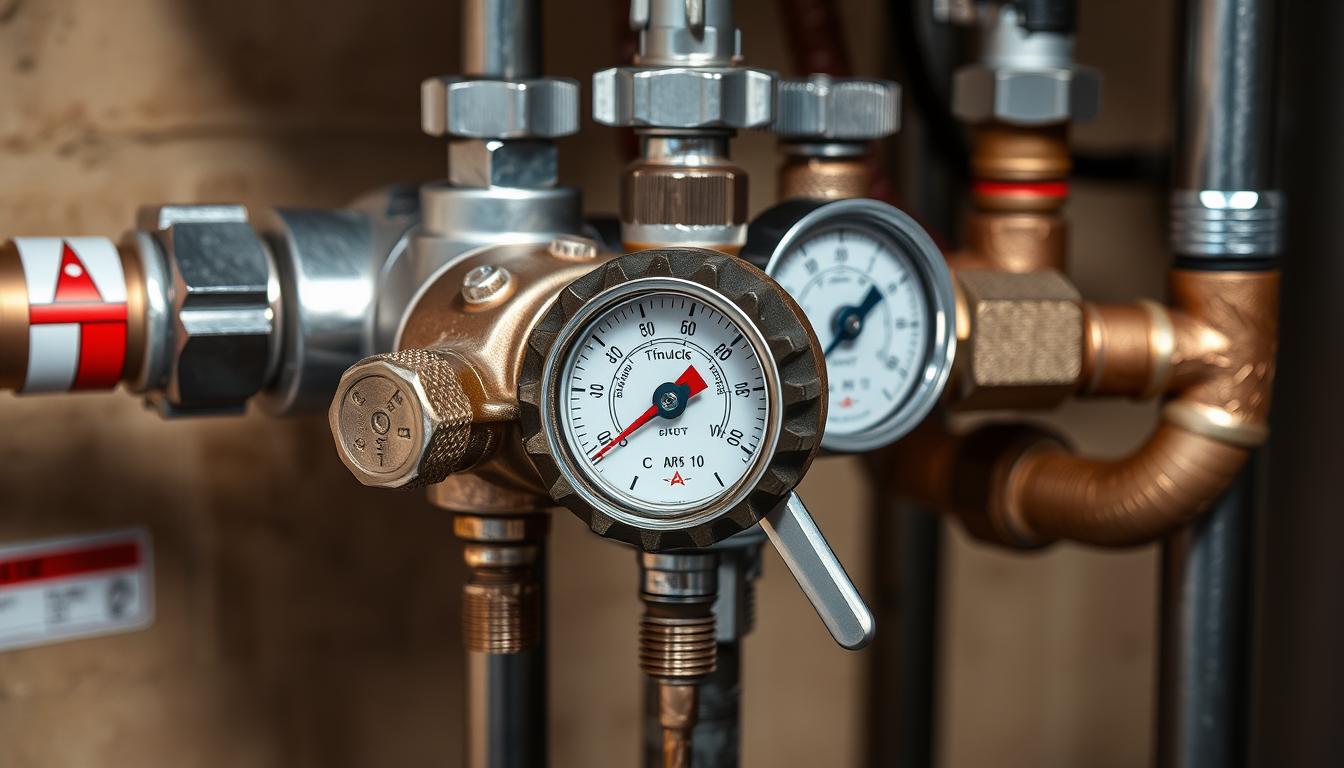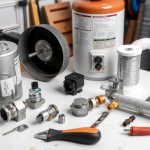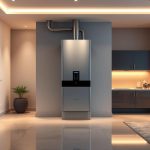Every homeowner remembers the shock of hot water suddenly coming out of the faucet. My family had a close call with my nephew almost getting burned. This made me look into water heater safety.
The water heater tempering valve is more than a plumbing part. It’s a key to keeping your family safe from burns. It makes sure the water isn’t too hot for anyone.
Recently, rules for home inspections have changed. Now, inspectors must check if water heaters have these valves. This shows how important they are for keeping homes safe.
Key Takeaways
- Water heater tempering valves prevent dangerous scalding incidents
- Plumbing codes increasingly require these safety devices
- Valves contribute to energy efficiency and temperature control
- Professional installation ensures optimal performance
- Regular maintenance extends valve and water heater lifespan
What is a Water Heater Tempering Valve?

Water heater tempering valves are key to keeping homes safe and comfortable. They mix hot and cold water to avoid scalding. This ensures water is always at a safe temperature.
A water mixing valve, or anti-scald valve, blends hot and cold water. It keeps the water temperature safe and comfortable. Its main job is to stop water from getting too hot, which could cause burns.
Key Components and Functionality
The tempering valve has a few important parts:
- Thermostatic element for temperature sensing
- Hot water inlet connection
- Cold water inlet connection
- Mixed water outlet
- Temperature adjustment mechanism
How It Works
The valve uses smart sensors to check and control water temperature. It mixes hot and cold water to keep it around 120°F (49°C). This keeps the water safe from scalding.
“Safety is not an accident, but a deliberate and continuous process of risk management.” – Unknown
Importance for Home Safety
Tempering valves are vital for keeping people safe. They are most important in:
- Hospitals and healthcare facilities
- Residential homes
- Schools and public buildings
- Care facilities for seniors
Experts say to have a pro install it right. It’s a smart move to protect your family from water injuries.
Benefits of Installing a Tempering Valve
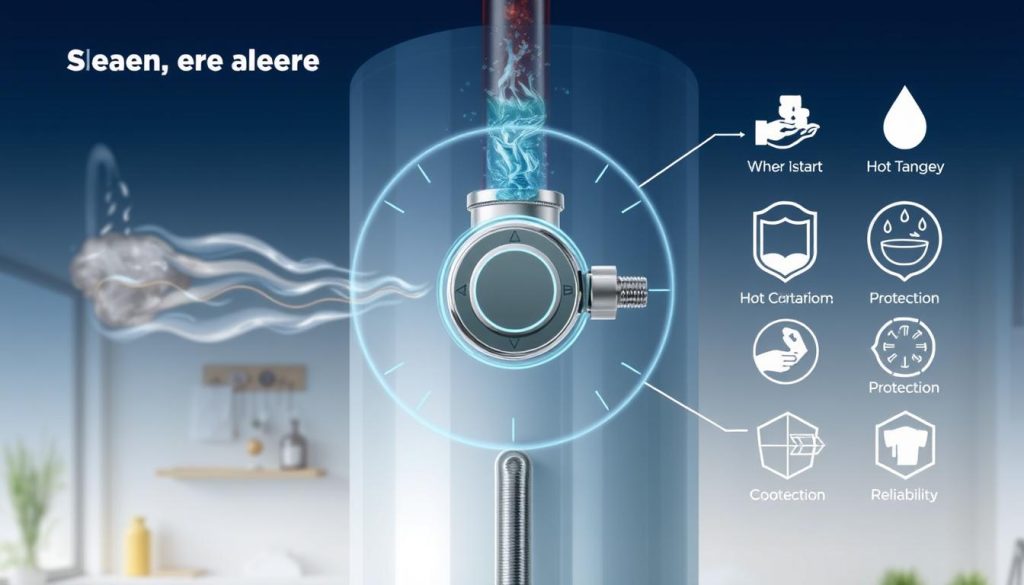
Keeping your water heater safe is very important. A thermal protection valve does more than just control temperature. It protects and makes your water system more efficient.
- Enhanced Personal Safety
- Improved Water Heater Performance
- Energy Conservation
Prevents Scalding Risks
A water heater safety valve keeps your family safe from hot water. It meets standards like ASSE 1016. These valves act fast to stop hot water bursts that could burn you.
Protecting vulnerable populations like children and elderly is key in managing water temperature.
Enhances Water Heater Efficiency
A good thermal protection valve lets water heaters heat water more for safety. But it also keeps the water warm when you need it. This way, your system works well without risking safety.
| Valve Type | Temperature Range | Primary Use |
|---|---|---|
| Green Cap Valve | 120-140°F | Residential Applications |
| Blue Cap Valve | 110-130°F | Medical/Laboratory Settings |
Contributes to Energy Savings
Tempering valves mix hot and cold water smartly. This means you use less hot water. This leads to lower energy bills and helps the environment.
These valves are now required by law. Getting a good hot water temperature limiter means safer, more efficient, and cheaper water heating in the long run.
Types of Water Heater Tempering Valves

Water heater blending valves are key for managing water temperature and safety at home. Each type has special features for different needs in controlling hot water.
Manual vs. Automatic Valves
There are two main types of water heater tempering valves:
- Manual Valves: Need you to adjust the temperature yourself
- Automatic Valves: Adjust the temperature on their own, so you don’t have to watch it all the time
Pressure-Relief Valves
Pressure-relief valves are very important for safety. They stop the water heater from getting too pressurized. This keeps the system safe and everyone in the house safe too.
Thermostatic Mixing Valves
Thermostatic mixing valves are the latest in water heater technology. They:
- Mix hot and cold water automatically
- Keep the water at a steady temperature
- Help avoid scalding
ASSE Standard 1017 says mixing valves need check valves for the best performance and safety.
Each valve type has a special cap color. This color shows what kind of heater it’s for:
| Cap Color | Application |
|---|---|
| Blue | Electric Heaters |
| Orange | Heat Pump/Solar Heaters |
| Green | Gas-Powered Heaters |
| Black | Commercial Systems |
Knowing about these valve types helps homeowners choose the right one for their needs. This ensures the best control over hot water temperature.
How to Choose the Right Tempering Valve
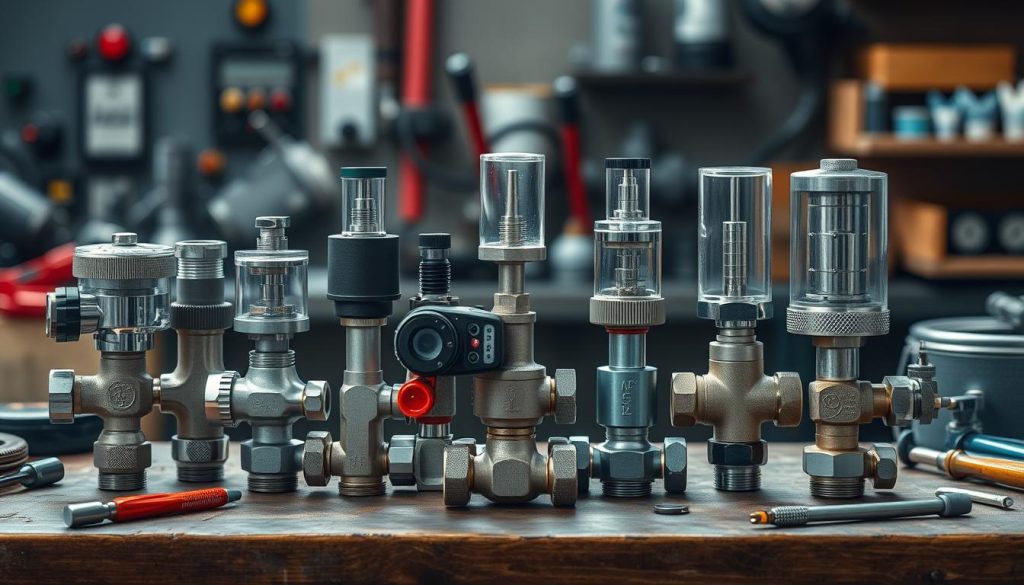
Choosing the right water heater tempering valve is key for home safety and hot water efficiency. The correct anti-scald valve keeps your family safe from scalding risks. It also helps keep your water heating efficient.
When picking a tempering valve, look at several important factors. These factors affect your home’s hot water system. Knowing these will help you choose wisely, ensuring safety and function.
Residential Considerations for Tempering Valves
- Assess your household’s hot water usage patterns
- Consider the size and type of existing water heater
- Evaluate the number of bathrooms and fixtures
- Check local building code requirements
Professional Recommendations
Plumbing experts often recommend these when choosing a hot water safety valve:
| Valve Type | Recommended For | Temperature Accuracy |
|---|---|---|
| Blue Cap Tempering Valve | Electric Water Heaters | Within 3°C |
| Green Cap Tempering Valve | Gas Hot Water Systems | Within 3°C |
| Thermostatic Mixing Valve | Precision Temperature Control | Within 1°C |
Compatibility with Existing Systems
When picking an anti-scald valve, make sure it’s compatible. Make sure the tempering valve fits your water heater’s size and works well with your plumbing. Important factors include pipe size, water pressure, and system setup.
“A well-chosen tempering valve is your first line of defense against scalding accidents.” – Plumbing Safety Expert
Spending time to pick the right water heater tempering valve is worth it. It prevents costly changes and keeps your home safe for years.
Installation Process of Tempering Valves

Knowing how to install a water heater tempering valve is key for homeowners. It makes your water system safer and more efficient. Whether you do it yourself or hire a pro, understanding the steps and challenges is important.
DIY vs. Professional Installation
Deciding between DIY or hiring a pro depends on several things:
- How much plumbing experience you have
- The complexity of your water system
- Local building codes
- The tools you have
“Proper installation is the cornerstone of effective temperature control and safety in your home’s water system.”
Step-by-Step Installation Guide
- Turn off the main water supply
- Drain the water lines
- Find the hot and cold water connections
- Get your pipe fittings ready
- Mount the tempering valve securely
- Connect the water lines
- Test if it works right
Common Mistakes to Avoid
Experts say to avoid these mistakes when installing a tempering valve:
- Incorrect valve orientation
- Wrong pipe measurements
- Not sealing connections well
- Not doing a pressure test
- Ignoring the manufacturer’s instructions
Being precise is vital in fitting a thermal protection valve. Each connection must be done carefully to avoid leaks or malfunctions.
Professional Recommendations
| Recommendation | Details |
|---|---|
| Safety Gear | Wear protective gloves and eyewear |
| Tools | Use an adjustable wrench, pipe cutter, and Teflon tape |
| Verification | Pressure test all connections |
While DIY is possible, getting a pro ensures your system works best and meets local rules. If unsure, always ask a licensed plumber for a safe and effective installation.
Maintenance Tips for Water Heater Tempering Valves

Keeping your water heater tempering valve in good shape is key for home safety and performance. Homeowners can keep their hot water system running well by following some simple upkeep steps.
Routine Checks and Adjustments
Regular care for your anti-scald valve includes a few important steps:
- Check the tempering valve every six months
- Look for signs of wear or corrosion
- Make sure the water temperature is right
- Test if the valve moves smoothly
Signs Maintenance is Required
Watch out for these signs that your water heater tempering valve needs attention:
- Inconsistent water temperature
- Lower water pressure
- Strange noises when water flows
- Leaks around the valve
Recommended Cleaning Procedures
Good upkeep of your hot water system needs the right cleaning methods. Experts suggest getting a professional to check your valve every year. This keeps it working well and stops it from breaking down.
“Regular maintenance can extend your water heater’s lifespan by up to 50% and prevent costly repairs.”
Some key stats show why regular care is so important:
- Drain the tank every six months to remove minerals
- Check the sacrificial anode rod yearly to stop corrosion
- Get a yearly professional check to maybe double your unit’s life
By following these maintenance tips, you can ensure your hot water is safe and efficient. This also helps avoid unexpected problems and breakdowns.
Understanding Valve Regulations

Water heater tempering valve regulations are key to keeping homes safe. They prevent scalding and ensure water systems work well.
Understanding hot water safety standards is complex. It involves knowing several important parts of plumbing codes.
Local and National Codes
Rules for water heater tempering valves differ by place. Important standards include:
- AS 4032.2 – Australian standard for tempering valve requirements
- NHS D08 – Healthcare-specific water safety guidelines
- EN 1111 – European standards for mixing valve performance
Importance of Compliance
Following plumbing codes is more than a law. It’s a safety must. It helps:
- Stop scalding incidents
- Keep water temperature steady
- Lower bacterial growth risk
Maintaining proper water temperature is essential for both safety and health.
Consequences of Non-Compliance
Ignoring water heater tempering valve rules can lead to big problems:
- Legal liability for injuries
- Failed building inspections
- Potential insurance claim rejections
Homeowners and contractors need to know the latest rules. This ensures hot water systems are safe and efficient.
Troubleshooting Common Issues

Fixing water heater tempering valve problems needs a careful plan. Homeowners often face issues with controlling hot water temperatures. These problems can make the system unsafe and less efficient.
It’s important to know the signs of anti-scald valve issues. Experts say regular checks are key to avoid bigger problems.
Recognizing Malfunctions
- Inconsistent water temperatures
- Sudden temperature drops
- Low water pressure
- Unusual noises in plumbing system
- Dripping hot water taps
Common Solutions for Valve Issues
Several steps can help fix tempering valve problems:
- Clean the valve to remove sediment buildup
- Check and adjust temperature settings
- Inspect for visible leaks or damage
- Verify proper valve calibration
When to Call a Professional
Some issues need a pro’s help. Get expert help when:
- Temperature changes keep happening after trying to fix it yourself
- You can’t control the water temperature
- There are leaks or big damage
- The valve doesn’t work right after trying to fix it
Regular yearly checks can stop big problems and make your tempering valve last longer.
Diagnostic Insights
| Symptom | Potential Cause | Recommended Action |
|---|---|---|
| Inconsistent Water Temperature | Valve Calibration Issue | Professional Inspection |
| Low Water Pressure | Sediment Buildup | Valve Cleaning |
| Complete Hot Water Failure | Valve Mechanism Failure | Replacement Required |
How to Test a Tempering Valve

Keeping your home’s hot water system safe and efficient is key. Homeowners must regularly test their water heater tempering valves. This ensures the thermal protection valve works well.
Importance of Regular Testing
Checking the hot water temperature often is vital to avoid scalding. Here are some important facts:
- At 68°C, a full-thickness scald can occur in just one second
- At 50°C, scalding takes five minutes
- Legislation requires tempering valves in various residential and commercial installations
Step-by-Step Testing Procedures
To test a tempering valve, follow these steps:
- Gather necessary tools:
- Digital thermometer
- Stopwatch
- Notebook for recording measurements
- Run hot water at different outlets
- Measure water temperature at each point
- Compare readings against recommended standards
Interpreting Test Results
It’s important to understand your test results. Here’s a quick guide:
| Temperature Range | Assessment | Recommended Action |
|---|---|---|
| Below 120°F (49°C) | Safe Range | No immediate action required |
| Above 120°F (49°C) | Potential Risk | Adjust or replace tempering valve |
| Inconsistent Temperatures | Valve Malfunction | Professional inspection recommended |
“Proactive testing can prevent scalding injuries and extend the life of your hot water system.” – Plumbing Safety Expert
If you see signs of a failing tempering valve, like temperature changes or low pressure, call a professional plumber right away. Regular checks and maintenance keep your system safe and efficient.
Innovations in Tempering Valve Technology

The world of water heater tempering valves is changing fast. New technologies are making our home water systems smarter and more efficient. These advancements are changing how we control our hot water.
Smart Valves and Connectivity
Today’s water heater tempering valves come with smart features. You can now check and change your water temperature from your phone. Some key features include:
- Real-time temperature monitoring
- Remote temperature adjustments
- Detailed water usage analytics
- Maintenance alerts and notifications
Advanced Safety Features
New systems focus on keeping you safe. They have advanced safety features like:
- Automatic shut-off during malfunctions
- Precise temperature control within ±4°F
- Fail-safe temperature limiting
- Integrated anti-scalding protection
Environmental Considerations
Manufacturers are making water heaters more energy-efficient. Innovative tempering valves now optimize water heating processes, cutting down energy use. They support green home technologies too.
The future of water heating lies in smart, connected, and environmentally conscious solutions.
These new valves bring big changes to home water heating. They offer better convenience, safety, and efficiency. Thanks to digital controls and WiFi, they’re a big step forward.
Cost Considerations
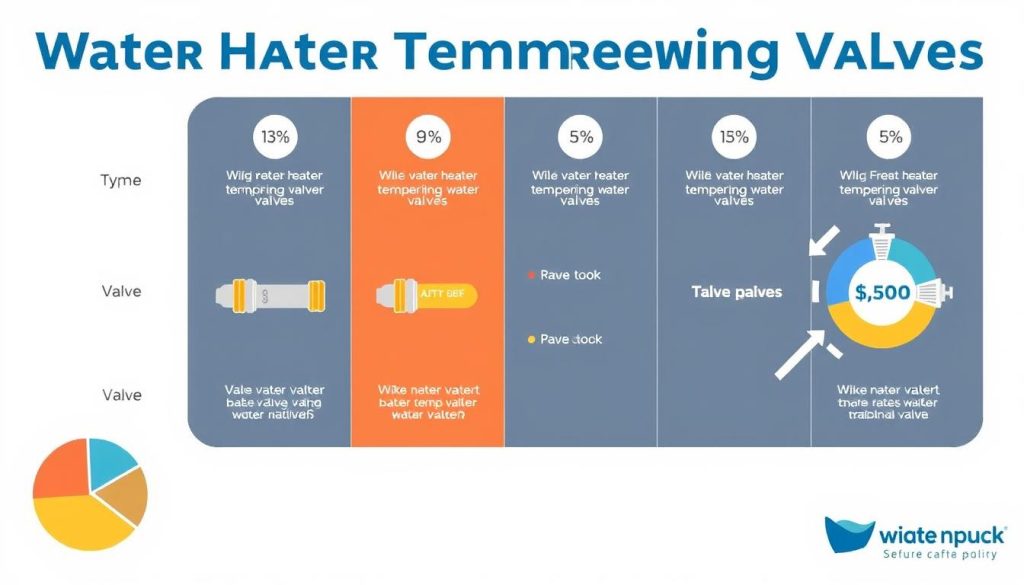
Buying a water heater tempering valve is a big decision for homeowners. It’s about safety and saving energy. Knowing the cost helps you choose the right device for your home.
Average Price Range for Valves
Prices for hot water safety valves vary a lot. This depends on the technology and features. Here are some typical price ranges:
- Basic manual tempering valves: $50 – $150
- Advanced thermostatic mixing valves: $150 – $300
- Smart anti-scald device investment: $300 – $500
Installation Cost Breakdown
| Service Type | Estimated Cost |
|---|---|
| Professional Installation | $100 – $300 |
| DIY Installation Materials | $25 – $75 |
| Total Possible Investment | $175 – $675 |
Return on Investment Analysis
The investment in an anti-scald device pays off in the long run. Preventing scalding accidents can save thousands in medical bills. It also keeps your family safe.
A small upfront cost in a tempering valve can prevent serious injuries. It also gives you peace of mind.
Energy savings are key to making it worth it. You could save almost $550 a year. Plus, it lowers the risk of accidents, making it a smart choice.
Water Heater Tempering Valves and Plumbing Standards

Understanding plumbing standards is key. It involves knowing about water heater tempering valves and their role in safety. Both plumbers and homeowners need to know the rules for these devices.
Overview of Plumbing Codes
Plumbing standards for tempering valves aim to keep people safe from water dangers. The American Society of Sanitary Engineering (ASSE) sets strict standards. These standards cover how these valves should work and be safe.
- ASSE 1016 covers automatic compensating valves for individual fixture systems
- ASSE 1070 specifies safety criteria for water temperature control devices
- National and local building codes mandate specific installation requirements
Compliance with the International Plumbing Code (IPC)
Following the IPC is vital for water heater safety. The code outlines how to install tempering valves. This ensures water is not too hot, keeping everyone safe.
| Application | Maximum Safe Temperature | Recommended Setting |
|---|---|---|
| Residential Fixtures | 120°F (49°C) | 110°F (43°C) |
| Commercial Settings | 110°F (43°C) | 105°F (41°C) |
| Healthcare Facilities | 105°F (41°C) | 100°F (38°C) |
Best Practices for Installation
Installing tempering valves right is key for safety. Experts suggest:
- Get a pro to check your plumbing first
- Choose the right valve size for your needs
- Put the valve in the right spot in your plumbing
- Make sure it’s easy to maintain
Following plumbing standards is more than just rules. It’s about keeping people safe and avoiding harm.
By following these plumbing standards, we can make water heating systems safer and more efficient. This meets the strict IPC requirements.
Comparing Brands and Models
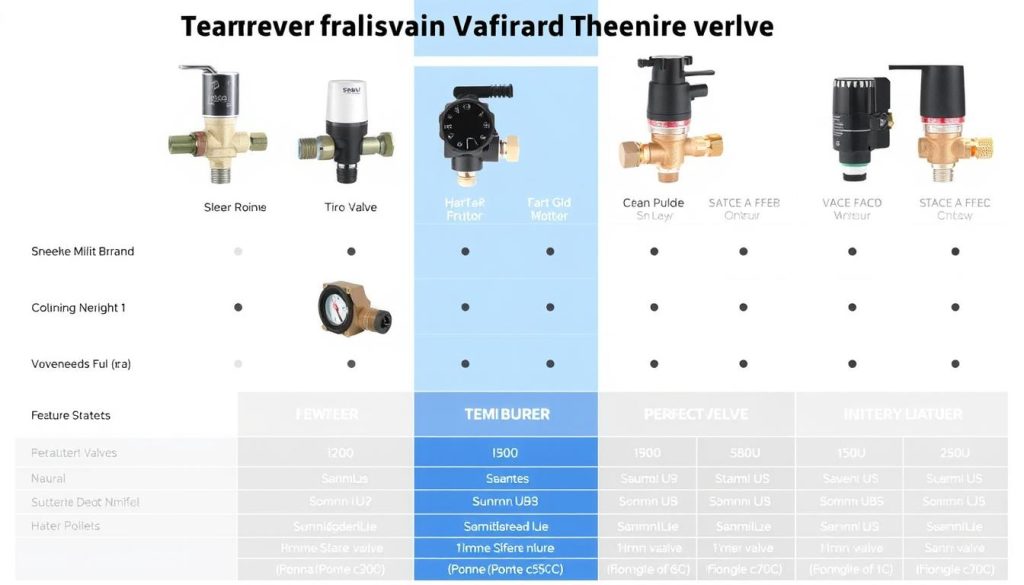
Choosing the right water heater tempering valve is key for home safety and managing water temperature. Knowing the top brands helps homeowners pick the best for their hot water systems.
- Honeywell: Known for advanced temperature control technology
- Watts: Renowned for durability and precision
- Cash Acme: Specializes in reliable mixing valve solutions
- Bradley: Offers innovative safety-focused designs
Key Features and Specifications
When comparing hot water safety valves, look at these key factors:
| Brand | Temperature Range | Accuracy | Price Range |
|---|---|---|---|
| Honeywell | 40-50°C | ±1% | $75-$150 |
| Watts | 40-55°C | ±2% | $60-$130 |
| Cash Acme | 35-50°C | ±3% | $50-$100 |
| Bradley | 40-52°C | ±1.5% | $80-$170 |
Customer Reviews and Ratings
What do customers say? Here are some key points:
- Ease of Installation: Watts and Honeywell get high praise
- Durability: Cash Acme is known for lasting long
- Customer Support: Bradley is praised for its help
“Choosing the right tempering valve is not just about price, but about ensuring your family’s safety and comfort.” – Professional Plumbing Association
When picking a tempering valve, think about expert advice, system compatibility, and your home’s needs. This will help you make a smart choice.
The Future of Water Heater Tempering Valves
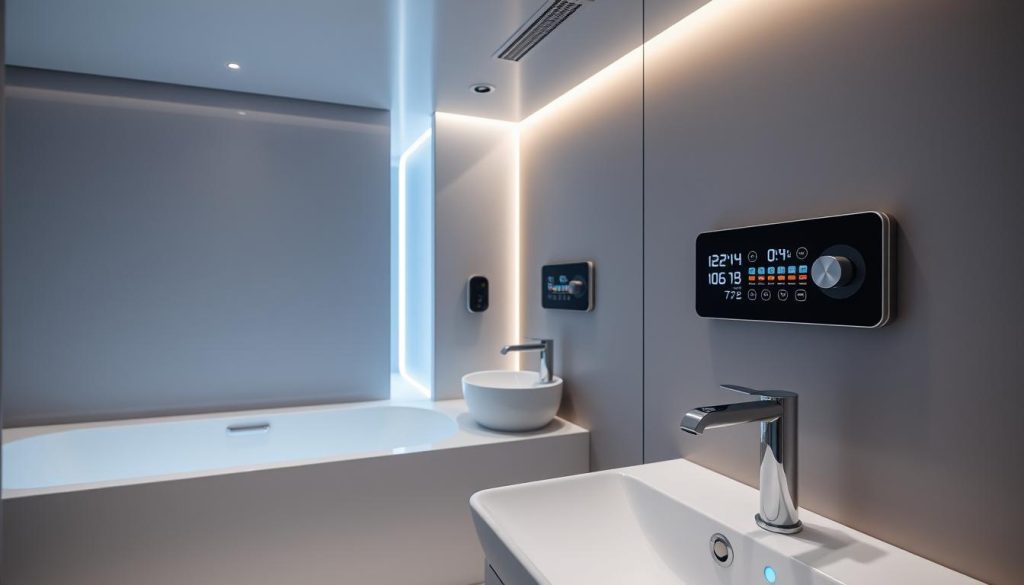
The world of water heater tempering valves is changing fast. New tech and a push for safety and efficiency are leading the way. Smart water temperature control is making it easier for homeowners to manage their hot water.
Emerging Trends in Home Safety Technologies
Future tempering valves will bring big changes to eco-friendly hot water systems. They will come with advanced features:
- AI-powered temperature monitoring
- Real-time smartphone connectivity
- Predictive maintenance alerts
- Energy consumption optimization
Potential Regulatory Developments
Rules on water safety and efficiency are getting tighter. We might see:
- Stricter temperature control standards
- Enhanced scalding prevention requirements
- Mandatory energy efficiency ratings
Water Efficiency Innovations
The future of tempering valves will focus on saving water. New tech will help:
- Precise temperature calibration
- Reduced water waste
- Intelligent heat management
“Smart tempering valves represent the next frontier in home water management, combining safety, efficiency, and technological sophistication.”
Homeowners can look forward to smarter, more efficient, and eco-friendly water temperature control soon.
Frequently Asked Questions (FAQs)
Homeowners often wonder about water heater tempering valves and their role in safety. These FAQs answer key questions about temperature, lifespan, and installation for home water systems.
What is the Ideal Temperature Setting?
The best temperature for hot water safety is between 40 to 50 degrees Celsius (104-122°F). Most plumbers suggest setting tempering valves at 120°F. This balance prevents scalding while keeping water hot enough for use.
How Long Do Tempering Valves Last?
Valves usually need to be replaced every 4-5 years, lasting about 5 years on average. Regular checks and cleaning can make them last longer. This ensures your hot water system works well.
Can I Install a Valve Myself?
It’s best to have a pro install tempering valves. Even skilled DIY folks might struggle with local codes. Plumbers know how to set temperatures right, keeping your water safe and avoiding warranty issues.
